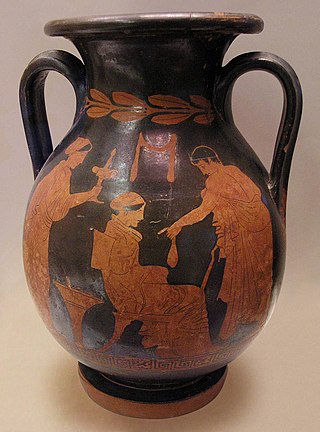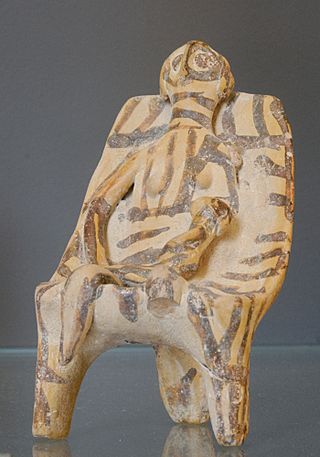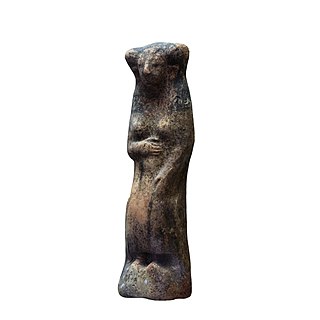Related Research Articles

Aphrodite is an ancient Greek goddess associated with love, lust, beauty, pleasure, passion, procreation, and as her syncretized Roman goddess counterpart Venus, desire, sex, fertility, prosperity, and victory. Aphrodite's major symbols include seashells, myrtles, roses, doves, sparrows, and swans. The cult of Aphrodite was largely derived from that of the Phoenician goddess Astarte, a cognate of the East Semitic goddess Ishtar, whose cult was based on the Sumerian cult of Inanna. Aphrodite's main cult centers were Cythera, Cyprus, Corinth, and Athens. Her main festival was the Aphrodisia, which was celebrated annually in midsummer. In Laconia, Aphrodite was worshipped as a warrior goddess. She was also the patron goddess of prostitutes, an association which led early scholars to propose the concept of "sacred prostitution" in Greco-Roman culture, an idea which is now generally seen as erroneous.

Venus is a Roman goddess whose functions encompass love, beauty, desire, sex, fertility, prosperity, and victory. In Roman mythology, she was the ancestor of the Roman people through her son, Aeneas, who survived the fall of Troy and fled to Italy. Julius Caesar claimed her as his ancestor. Venus was central to many religious festivals, and was revered in Roman religion under numerous cult titles.

Sacred prostitution, temple prostitution, cult prostitution, and religious prostitution are purported rites consisting of paid intercourse performed in the context of religious worship, possibly as a form of fertility rite or divine marriage. Scholars prefer the terms "sacred sex" or "sacred sexual rites" in cases where payment for services is not involved.

In Greek mythology, Peitho is the personification of persuasion. She is typically presented as an important companion of Aphrodite. Her opposite is Bia, the personification of force. As a personification, she was sometimes imagined as a goddess and sometimes an abstract power with her name used both as a common and proper noun. There is evidence that Peitho was referred to as a goddess before she was referred to as an abstract concept, which is rare for a personification. Peitho represents both sexual and political persuasion. She is associated with the art of rhetoric.

Astarte is the Hellenized form of the Ancient Near Eastern goddess ʿAṯtart. ʿAṯtart was the Northwest Semitic equivalent of the East Semitic goddess Ishtar.

Hieros gamos, or hierogamy is a sacred marriage that takes place between gods, especially when enacted in a symbolic ritual where human participants represent the deities.

Anahit was the goddess of fertility and healing, wisdom and water in Armenian mythology. In early periods she was the goddess of war. By the 5th century BCE she was the main deity in Armenia along with Aramazd. The Armenian goddess Anahit is related to the similar Iranian goddess Anahita. Anahit's worship, most likely borrowed from the Iranians during the Median invasion or the early Achaemenid period, was of paramount significance in Armenia. Artaxias I erected statues of Anahit, and promulgated orders to worship them.

Prostitution was a common aspect of ancient Greece. In the more important cities, and particularly the many ports, it employed a significant number of people and represented a notable part of economic activity. It was far from being clandestine; cities did not condemn brothels, but rather only instituted regulations on them.

In Greco-Roman mythology, the Propoetides are the daughters of Propoetus from the city of Amathus on the island of Cyprus.
Prostitution in Cyprus is not illegal, but operating brothels, organising prostitution rings, living off the profits of prostitution, encouraging prostitution or forcing a person to engage in prostitution are illegal activities.

In Ancient Greek religion and mythology, the Erotes are a collective of winged gods associated with love and sexual intercourse. They are part of Aphrodite's retinue. Erotes is the plural of Eros, who as a singular deity has a more complex mythology.

Prostitution has been practiced throughout ancient and modern cultures. Prostitution has been described as "the world's oldest profession", though this is unverifiable, and most likely incorrect.
The Aphrodisia festival was an annual festival held in Ancient Greece in honor of the goddess of love and beauty, Aphrodite. It took place in several Ancient Greek towns, but was especially important in Attica and on the island of Cyprus, where Aphrodite was venerated with a magnificent celebration. The festival occurred during the month of Hekatombaion, which modern scholars recognize as starting from the third week in July to the third week of August on the Gregorian calendar. Aphrodite was worshipped in most towns of Cyprus, as well as in Cythera, Sparta, Thebes, Delos, and Elis, and her most ancient temple was at Paphos. Textual sources explicitly mention Aphrodisia festivals in Corinth and in Athens, where the many prostitutes that resided in the city celebrated the festival as a means of worshipping their patron goddess. Though no textual sources expressly mention an Aphrodisia festival in Cythera, Thebes, or Elis, it likely occurred since textual and iconographical sources indicate that Aphrodite Pandemos had a cult following in these areas. The Aphrodisia festival was one of the most important ceremonies in Delos, though not much is known about the details of the celebration. The inscriptions merely indicate that the festival required the purchase of ropes, torches and wood, which were customary expenses of all Delian festivals.

Kourotrophos is the name that was given in ancient Greece to gods and goddesses whose properties included their ability to protect young people. Numerous gods are referred to by the epithet such as Athena, Apollo, Hermes, Hecate, Aphrodite, Artemis, Eileithyia, Demeter, Gaia, Cephissus and Asclepius. They were usually depicted holding an infant in their arms. Deianeria and Ariadne were occasional shown on vases with their children, Hyllus and Staphylos and Oenopion respectively, but there is no evidence that there was a cult around them as kourotrophic figures.
Aphrodite Areia or "Aphrodite the Warlike" was a cult epithet of the Greek goddess Aphrodite, in which she was depicted in full armor like the war god Ares. This representation was found in Sparta and Taras. There were other, similarly martial interpretations of the goddess, such as at her Sanctuary at Kythira, where she was worshiped under the epithet Aphrodite Urania, who was also represented as being armed. The epithet "Areia", meaning "warlike", was applied to other gods in addition to Aphrodite, such as Athena, Zeus, and possibly Hermes.
The Temple of Aphrodite at Acrocorinth was located in a sanctuary on the acropolis in Ancient Corinth dedicated to the goddess Aphrodite. It was the main temple of Aphrodite in Corinth, and famous for its alleged temple prostitution.

The Sanctuary of Aphrodite Paphia was a sanctuary in ancient Paphos on Cyprus dedicated to the goddess Aphrodite. Located where the legendary birth of Aphrodite took place, it has been referred to as the main sanctuary of Aphrodite, and was a place of pilgrimages in the ancient world for centuries. The ruins of the sanctuary were inscribed on the UNESCO World Heritage List in 1980, due to their historical religious significance.

Dea Gravida or Dea Tyria Gravida was either a goddess or representation of mortal women that were associated with procreation and fertility deriving from Phoenician culture and spreading within the Phoenician circle of influence. Although not much is known about the cult surrounding Dea Gravida, votive terracotta statues have been found throughout the Mediterranean, most notably in Phoenicia and Cyprus. The figure differs from kourotrophic figures that hold babies and are not visibly pregnant.

Artimpasa was a complex androgynous Scythian goddess of fertility who possessed power over sovereignty and the priestly force. Artimpasa was the Scythian variant of the Iranian goddess Arti/Aṣ̌i.
References
- 1 2 Keating, Sara. "'Sacred Prostitution': An ancient tradition based on respect for the woman". The Irish Times. Retrieved 2021-12-14.
- ↑ Beard, Mary; Henderson, John (1997). "With This Body I Thee Worship: Sacred Prostitution in Antiquity". Gender & History. 9 (3): 480–503. doi:10.1111/1468-0424.00072. S2CID 145105205.
- 1 2 Perrottet, Tony (7 August 2017). "Ancient Greek Temples of Sex". The Smart Set. Retrieved 2021-12-14.
- 1 2 3 4 5 "USMAI Libraries Login".
- 1 2 3 Kapparis, Konstantinos (2017-10-23). "5. The Economics of Ancient Prostitution". Prostitution in the Ancient Greek World. De Gruyter. pp. 265–314. doi:10.1515/9783110557954-005. ISBN 978-3-11-055795-4.
- 1 2 Anagnostou‑Laoutides, Eva; Charles, Michael B. (2018-12-01). "Herodotus on Sacred Marriage and Sacred Prostitution at Babylon". Kernos. Revue internationale et pluridisciplinaire de religion grecque antique (31): 9–37. doi: 10.4000/kernos.2653 . ISSN 0776-3824. S2CID 158893897.
- ↑ GLAZEBROOK, ALLISON (2010). Budin, S.L. (ed.). "Sacred Prostitution". The Classical Review. 60 (2): 491–493. doi:10.1017/S0009840X10000764. ISSN 0009-840X. JSTOR 40930813. S2CID 163153134.